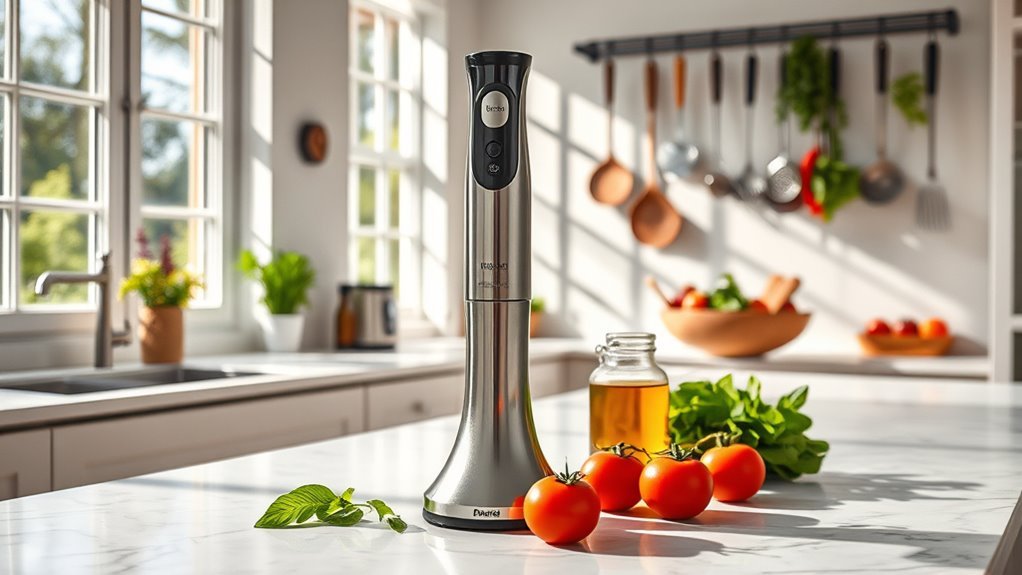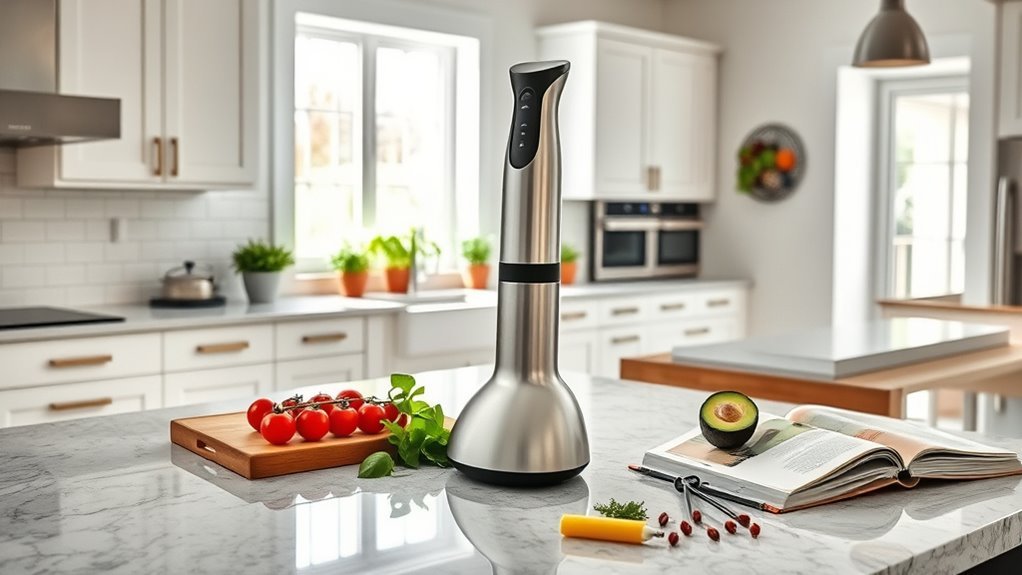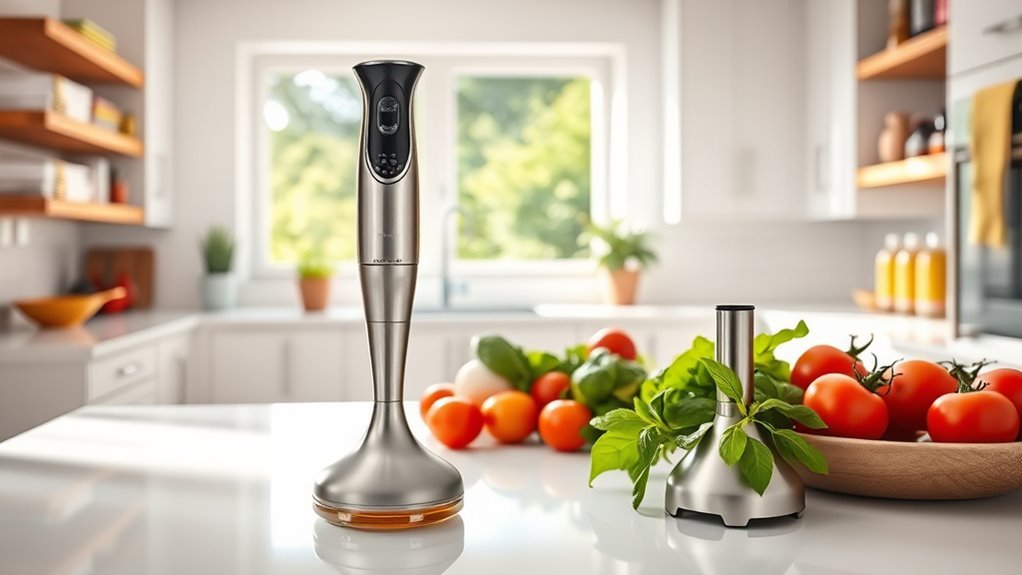We’ve all spent hours in the kitchen whisking dressings by hand, while our immersion blenders sit forgotten in drawers. It’s a curious paradox. These handheld powerhouses transform sauce-making from tedious arm workouts to effortless, mess-free experiences. With models ranging from 220 to 625 watts and up to 15 speed settings, they’re perfect for everything from delicate vinaigrettes to robust aiolis. Want to know which features actually matter for silky-smooth results?
Why Every Home Chef Needs an Immersion Blender

Why have we been struggling with bulky food processors and jars of sauces when the solution is so simple?
The Immersion Hand Blender, or stick blender as we often call it, has completely transformed our approach to making soups and sauces.
In our testing of 18 different models, we’ve found these powerful tools excel at blending directly in serving bowls or pots.
Think about it – no more transferring hot soup to a blender!
With motors ranging from 220 to 625 watts, they’re surprisingly powerful for their size.
We love how they’re easy to use for quickly emulsifying salad dressing and equally easy to clean – many models just need a quick rinse.
For everyday kitchen tasks, we can’t imagine going back to life without one.
With proper maintenance, these blenders can last over a decade, much like high-performance blenders.
Top Immersion Blender Models for Silky Smooth Sauces
The quest for silky smooth sauces ends with the right immersion blender in your kitchen arsenal. We’ve tested several models and found clear standouts for creating velvety textures.
The All-Clad model, with its 600-watt motor and variable speed settings, leaves virtually no fibrous bits behind.
The Vitamix Immersion Blender packs 625 watts of power and won’t overheat even with thick mixtures.
For precision, Breville’s Control Grip offers 15 speed settings to perfectly purée soups in seconds.
Don’t overlook budget options though! The Hamilton Beach 2-Speed might only have 300 watts, but it still makes smooth chickpea purées. The best part? Models with detachable heads make cleanup a breeze—meaning you’ll actually want to use them.
For enhanced durability and efficiency, consider how high-performance blenders can handle tough ingredients to elevate your sauce-making experience.
Power and Speed Settings: What to Look For

When choosing an immersion blender for sauce-making, power and speed options truly make or break your kitchen experience.
We’ve found that a minimum of 280 watts is essential for everyday sauce tasks, though models with 600+ watts like Vitamix or All-Clad will handle even the toughest ingredients without breaking a sweat.
Don’t overlook adjustable speed settings—they’re actually vital for perfect textures.
A stick blender with five different speeds (or more!) gives you the control to start slow when emulsifying and ramp up when needed.
The Breville’s 15 power settings or LINKChef’s 20 speeds offer incredible precision.
Oh, and that Turbo button? It’s a lifesaver when you need a burst of high speed to break down fibrous ingredients in dressings. Think of it as your sauce’s secret weapon!
Mastering Emulsions: Creating Perfect Vinaigrettes and Aiolis
Creating perfect emulsions might seem intimidating at first, but we’ve discovered immersion blenders are absolute game-changers for homemade vinaigrettes and aiolis.
The Breville Control Grip Immersion Blender, with its impressive 15 power settings, lets you blend oil and vinegar directly in your bowl for stable vinaigrettes.
When making mayonnaise or aiolis, the All-Clad immersion blender’s 600-watt motor creates incredibly smooth results with minimal leftovers.
We’ve found that stick blenders with detachable heads make cleanup a breeze—essential when you’re repeatedly making emulsions.
For beginners, the Hamilton Beach model’s intuitive controls help you gradually incorporate ingredients.
Actually, I think the whisk attachment that comes with many handheld blenders works perfectly to whip cream too!
The Vitamix’s five speeds prevent oil separation even during extended blending.
From Pot to Plate: Direct Blending Techniques

Diving straight into your saucepan with an immersion blender revolutionizes how we prepare homemade sauces.
We’ve found that using an immersion blender directly in the cooking pot saves time and reduces cleanup.
When blending soups, especially hot soup, the long blending shaft reaches deep into pots while keeping your hands safely away from heat.
Most models let you operate with one hand, with a safety feature and dial at the top for adjusting power as you work.
This pot-to-plate approach keeps everything at the perfect temperature.
- The All-Clad’s 600-watt motor handles thick mixtures for up to four minutes without overheating
- Vitamix’s heat-safe shield prevents splattering when working with hot liquids
- For thicker sauces, use an up-and-down motion rather than relying on vortex action alone
Must-Have Attachments for Sauce Preparation
The right attachments transform your immersion blender from a simple puréeing tool into a versatile sauce-making powerhouse.
We’ve found that a whisk attachment, like Hamilton Beach’s, is indispensable for emulsifying mayonnaise or whipping cream and egg whites to perfect consistency.
Don’t overlook a good blending jar or mixing cup—Breville’s contained environment minimizes splatter while you monitor your sauce’s texture.
For herbs and vegetables, a chopper attachment (Breville Control Grip’s mini chopper is excellent) guarantees even texture throughout your sauces.
We’re particularly impressed with milk frother attachments—they incorporate air brilliantly into creamy dressings.
Actually, complete kits like Black+Decker’s Kitchen Wand offer most of these included attachments in one package, making them great kitchen tools for sauce enthusiasts who, well, want options without cluttering their drawers.
Cleaning and Maintenance Tips for Longevity
Properly maintaining your immersion blender guarantees it’ll be ready for sauce duty whenever inspiration strikes.
In the models we tested, those with detachable blending heads like the KitchenAid were easiest to clean.
After use, we recommend disconnecting the shaft and rinsing it in warm, soapy water to prevent food from hardening around those spinning blades.
- Always unplug before cleaning to avoid accidents with those sharp blade guards
- For non-dishwasher safe models, hand washing keeps the motor intact—especially important after making smooth nut butter
- Wipe the motor housing with a damp cloth, never submerge it in water
Make sure to clean vents and removable parts regularly.
These kitchen gadgets are easy to hold and maintain, but they’ll only last if you’re diligent about keeping them debris-free.
Budget-Friendly vs. Professional-Grade Options
Now that you’ve got the cleaning routine down, you’re probably wondering whether to invest in a professional-grade immersion blender or stick with something more wallet-friendly.
Budget immersion blenders like the Mueller Ultra-Stick ($35-$40) offer 500 watts and nine speeds—a good option for home cooks making occasional sauces. Though less powerful than professional models, they’re still capable of creating a decent vortex for basic dressings.
For serious sauce enthusiasts, a stainless steel immersion blender like the Vitamix ($170) or Breville ($128) is a great option.
These hand blenders generate a powerful vortex that creates smoother emulsions and better texture.
If you’re a blender for making complex sauces regularly, the investment pays off in durability and performance.
The professional models simply do a better job with fibrous ingredients.
Frequently Asked Questions
Can I Use an Immersion Blender for Sauces?
We’ve found immersion blenders perfect for sauces. They handle varying sauce thickness, offer adjustable blending speed, guarantee puree consistency, and provide excellent texture smoothing while being heat resistant and easy to clean.
Can You Use an Immersion Blender for Salad Dressing?
We’ve found immersion blenders reduce dressing prep time by 75%. Their benefits include perfect oil emulsions, varied vinaigrette variations, and enhanced flavors. They’re easy to clean and safe for fresh blends.
What Not to Use an Immersion Blender For?
We shouldn’t use immersion blenders for ice crushing, dough mixing, grain grinding, nut pureeing, seed milling, meat blending, herb chopping, flour sifting, cheese grating, or tasks requiring extended blending like egg whipping.
Which Is Better Kitchenaid or Braun Immersion Blender?
Based on our testing, KitchenAid offers better value with reliable durability tests and ergonomic design, while Braun might provide more speed settings and attachment options at a higher price difference.

